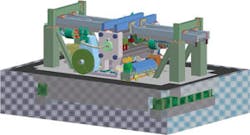Pre-Forming for Flexibility In Incremental Forming
Technology developers often choose a big stage to present their innovations, so it was fitting that Lasco Umformtechnik chose September’s EMO 2011 event in Hanover, Germany, to unveil its new forming line concept. EMO is a biannual expo for the machine tool sector, and Lasco develops machine tools and automation systems, as well as the forming lines with which forgers may be more familiar. But, the debut of the AR-D 320 at EMO also reflects on the closer alignment of a variety of production technologies for near-net parts.
The AR-D 320 is a stretching machine designed as a forging process line, conceived for use in incremental forming. It produces complex pre-forms from standard semi-finished products, with a focus on speeding up the process while bringing high precision to the finished parts. Like most new process technologies today, it’s also designed to conserve process energy consumption.
As outlined by Lasco’s Dipl.-Ing (FH) Herbert Rüger, the development of the new line proceeded from the observation that forgings produces may increase in size and weight, while the number of pieces decreases. With this in mind, Lasco developed the AR-D 320 so that the shape of the parts produced could be programmed and stored.
The line’s memory supports a nearly unlimited number of programs, Forming tools can be used universally, and a The AR-D is a design that proceeds from the observation that workpieces may increase in size and weight, but decrease in number. So, the shapes of parts can be programmed and saved, Pre-Forming For Flexibility variety of different workpieces can be produced without any time-consuming tool changes. It is efficient enough to support even small batch sizes.
Rüger continued to explain that pre-formed billets for producing automotive parts (e.g., front axles, crankshafts), can be manufactured with efficiency and versatility using the AR-D 320. The high operating speed allows production of pre-forms for even complex parts at one forging temperature. Simpler shapes can be forged directly after pre-forming.
The line itself is divided into two main parts: the forming unit and the two manipulators.
The forming unit consists of a press with horizontal operation and two rams moving toward each other in a sinusoidal motion, driven hydraulically. The ram movement is not realized via valve control. The hydraulic system works without any pulsation and with high efficiency, Rüger noted. A combination of electric servo motors and hydraulic pumps (servo pumps) allow the dynamic adjustment of the ram stroke position so parts with a variety of contours can be produced.
The forming force behind the AR-D 320 is 3,200 kN per die, with a frequency of 200 strokes/min. The two rams of the machine provide surfaces for attaching two different forming tools that allow, for example, production of rectangular and round cross-sections of a single part. The tool change is automatic and done in less than 10 seconds. With only two forming tools, there is a substantial reduction in the cross-section of a workpiece, without any tool change.
Driven exclusively by servo motors that are able to feed motions of up to 60 mm between two forming operations, the two manipulators are suspended in guide rails, able to be programmed flexibly. They operate in master/slave mode and transfer the forging billet from one side to the other, thereby forming the two ends of the billet. In longer parts, the second manipulator can be used as support to prevent the billet from unintentional bending.
Volume tolerances in the raw material naturally result in length tolerances of the pre-form. The AR-D 320 features exact laser measurement, providing the actual length of the workpiece, which can correct the gripper position of the individual slave manipulator.
Rüger reported that Lasco has delivered the AR-D 320 to a customer, which uses the new line for hot forming of high-alloyed steels. The customer produces 220×220 mm billets with a maximum weight of 200 kg. The pre-formed parts have a maximum length of 1,700 mm. Based on the initial operating experience, Lasco asserts that its goal of producing complex pre-forms from standard semifinished products has been accomplished, and in some circumstances exceeded.
